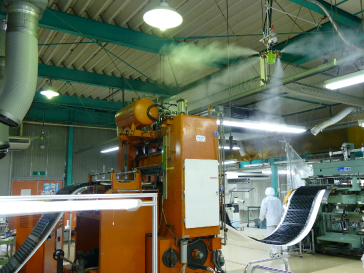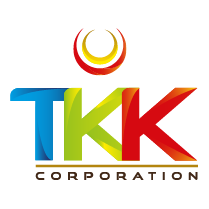IKEUCHI AirAKI®
Dry Fog Humidification System

This industrial-use humidification system uses fog that doesn’t wet anything it touches (Dry Fog*1) and is built to accommodate a wide range of demands and requirements.
By controlling humidity either in large spaces or narrowly defined locations, it is possible to completely eliminate problems caused by static electricity. The running cost is 1/5 of a comparable steam humidification system, resulting in dramatic energy savings.
Features
• Energy-saving pneumatic humidification system producing Dry Fog. (*1)
• Prevents dryness and static electricity, enabling higher manufactured product quality and lower defect rates.
• The running cost is 1/5 of a comparable steam humidification system.
• One humidifier (when using AKIMist® “E”) produces 2.4–9.6 liters/hour of Dry Fog.
• Support customers in site investigation, layout design, installation work and after-sales services.
*1) We define Dry Fog as a very fine fog with a uniform, mean droplet diameter (mean fog droplet size) of 10 μm or less.
Because Dry Fog’s exceedingly fine spray droplets remain intact without bursting when they come into contact with objects such as a walls and people, they do not wet these impact surfaces.
“Dry mist,” despite its similar name, has much larger droplets than Dry Fog and has no specified droplet diameter as part of its definition. Dry mist droplet sizes vary significantly by producer and product.
Applications
Static electricity prevention: Prevents/reduces troubles caused by static charge, such as product damage, (electrostatic damage) and debris/dust adhesion, etc.
Energy saving: The running-costs of our system are only one-fifth of a typical steam humidification system, resulting in drastic energy savings.
Cooling effects: The system also yields a cooling of about 2℃, reducing temperatures with evaporative cooling (using the principle of heat loss due to water evaporation of Dry Fog).
Health-related benefits: Maintaining a relative humidity level of 50% dramatically reduces cold viruses, influenza (flu) viruses and so forth, thus reducing worker absences caused by illness.
[ Electronics ]
• Preventing electrostatic discharge damage during assembly, mounting/installation and tests; preventing debris and dust adhesion; mitigating rises in incorrect-chucking rates; preventing mounting errors.
[ Paper & Pulp, Printing ]
• Rotogravure printing: Preventing ink pan and ink roll fires, preventing debris and dust adhesion to films and papers, dust suppression, reducing ink striation from doctor and/or plate cylinder, preventing adhesion of debris caused by ink’s electrostatic charge.
• Screen printing: Preventing print defects caused by feathering, misregistration, streaks, blurring, etc.; preventing fading caused by plate dryness; productivity improvements.
• Offset printing: Controlling moisture content of paper; preventing paper break (web break), jams, and misalignment; reducing paper tearing; improving folding precision; preventing color drift; preventing curl.
• Others: Form printing, humidification for cardboard production.
[ Automotive manufacturing ]
• Preventing dust and debris adhesion in the body and bumper coating, inspection processes; dust suppression in storage rooms; static charge prevention in vehicle electrical components production and circuit board mounting process; heatstroke countermeasures; shortening cycle times.
[ Plastics production ]
• Reducing work efficiency declines caused by static electric shock, preventing fires, preventing scattering of debris and body hair, preventing adhesion of debris, preventing toppling of stacked items caused by static electricity.
[ Inks, Paints and Coatings ]
• Preventing debris adhesion in painting/coating process; cissing prevention; preventing fires during paint/coating preparation processes, in areas around reaction tanks and mixers, and during filling processes for substances such as pigments and coatings.
[ Other industries ]
• Humidification and dust suppression in machine parts production, textile industry, agriculture, livestock and warehouses, etc.
Industries in which this nozzle is used
Electronics, Paper & Pulp, Printing, Automotive manufacturing






